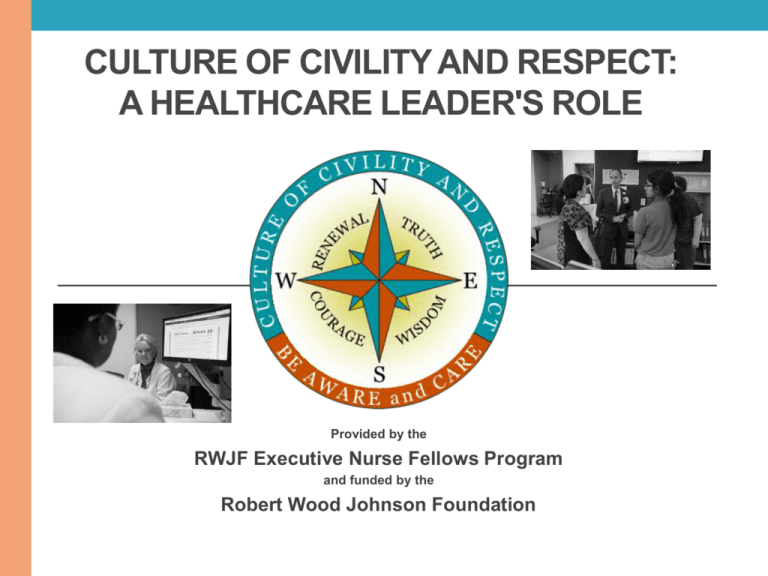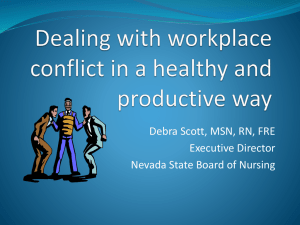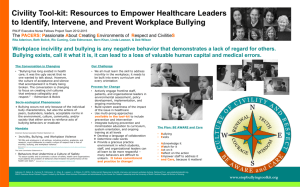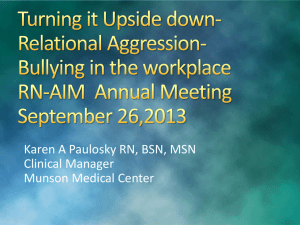- Stop Bullying Tool-Kit
advertisement

CULTURE OF CIVILITY AND RESPECT: A HEALTHCARE LEADER'S ROLE Provided by the RWJF Executive Nurse Fellows Program and funded by the Robert Wood Johnson Foundation Disclosure • The Speaker(s) is an 2012 RWJF Executive Nurse Fellow and member of a national project team focused on building a culture of respect in healthcare by reducing incivility and bullying in the workplace • Of the following I declare “no conflict”. • Salary • Royalty • Stock • Speaker’s Bureau • Consultant • No conflict Learning Objectives • Describe the effects of incivility and bullying on patient outcomes, human capital, and productivity in health care • Understand where to find tools and how to use them to build and sustain cultures of civility and respect in healthcare RWJF ENF Action Learning Team • Rita Adeniran, RN, DrNP, CMAC, NEA-BC FAAN President/CEO Innovative and Inclusive Global Solutions Drexel Hill, PA • Beth Bolick, RN, DNP, PPCNP-BC, CPNP-AC, FAAN Professor Rush University Medical Center College of Nursing, Chicago, IL • Ric Cuming, RN, MSN, EdD, NEA-BC, CNOR VP/Chief Nurse Executive Einstein Healthcare Network: Philadelphia, PA • Cole Edmonson, RN, DNP, FACHE, NEA-BC VP/Chief Nursing Officer Texas Health Resources: Presbyterian Dallas • Bernadette Khan, RN, MSN, NEA-BC VP Nursing and Patient Care Services New York Presbyterian Lower Manhattan Hospital • Linda B. Lawson, RN, DNP, NEA-BC Administrative Director for Health Care Transformation Sierra Providence Health Network - El Paso, TX • Debra White, RN, MSN, MBA, ACNS-BC, NEA-BC VP/Chief Nursing Officer Saint Luke’s Health System, Kansas City, MO • Listed alphabetically, not by weight of contribution This presentation may be used in full or part with attribution. The recommended citation is: Adeniran, R., Bolick, B., Cuming, R., Edmonson, C., Khan, B., Lawson, L., & Wilson, D. (2015). Culture of civility and respect: A healthcare leader’s role. www.stopbullyingtoolkit.org Defining Incivility & Bullying • Workplace incivility/bullying is any negative behavior that demonstrates a lack of regard for other workers. Call it what it is. • It can be displayed in a vast number of disrespectful behaviors including: • • • • • • • • • • Harassment Passive-aggressiveness Teasing Gossiping Purposely withholding business information Overruling decisions without a rationale Sabotaging team efforts Demeaning others Verbal intimidation Eye rolling “Bullying has long existed in health care; it was the ugly secret that no one wanted to talk about. However, the culture of acceptance and silence that accompanied it is finally being broken. The conversation is changing to focus on creating civil cultures that embrace collegiality and respect.” - Edmonson & Bolick Incivility & Bullying in the Headlines Nurse-to-nurse bullying more than just a sore point Workplace Bullying in Nursing: A Problem That Can’t Be Ignored MEDSURG Nursing—September/October 2009—Vol. 18/No. 5 When the Nurse Is a Bully Study Finds Nurses Frequently Being Bullied at Work Nursing News State of the Science • 35% percent of adult Americans (an estimated 54 million workers) report being bullied at work • Perhaps as many, if not more, are bystanders to the negative behavior. The group of bystanders includes not only our coworkers, but our patients, their families, and their visitors. State of the Science (cont.) • One in six nurses (13%) reported being bullied in the past six months (Sa & Fleming, 2008) • In a study on workplace bullying, most of the respondents reported being bullied by a person of authority (Johnson & Rea, 2009) Nurse to medical or nursing student, radiology tech, or fellow nurses Physician or manager to nurse or resident Section chief physician to fellow physician State of the Science (cont.) • However, incivility and bullying occur laterally, top down and bottom up, among every profession and within every profession and at every level of the organization • Everyone here has a story of when it happened to them • Everyone here has done it • Everyone here has been a silent bystander State of the Science (cont.) • Almost 21% of nursing turnover can be related to bullying (Johnson & Rea, 2009) • 60% of new RNs who quit their first job in nursing within 6 months report that it is because of being bullied • Replacing a nurse can cost up to $88,000 USD (Jones, CB, 2008) Replacing anyone is too expensive to ignore • According to a study by the US Bureau of National Affairs, there is a loss of productivity of $5-6 billion/year in the US due to bullying in the workplace State of the Science (cont.) • Bullying leads to erosion of professional competence as well as increased sickness, absenteeism, and employee attrition. Commitment to work quality and patient satisfaction declines (Hutchinson et al., 2010b; Johnson, 2009; Chipps & McRury, 2012; Porath & Pearson, 2013) • Bullying victims may suffer stress-related health problems, such as nausea, headache, insomnia, anxiety, depression, weight changes, and alcohol and drug abuse (Townsend, 2012) State of the Science (cont.) • Those who survive bullying early in their careers tend to carry their learned behaviors with them. They accept the bully culture as part of the job and eventually may choose to bully others (Townsend, 2012) Physical/Psychological Manifestations Common reactions: • Acute or chronic anxiety • Depression • Sleep interruptions • Fatigue • Lack of mental focus Post-traumatic stress disorder: • An experience that shatters all you had believed in and valued • Manifestation: Withdrawal, Conversion, Projection Effect on Patient Outcomes • Inattentive health care • Self-doubt • Dismissive treatment of patients • Patients may feel intimidated, embarrassed, or belittled Costs • Barrier to building and sustaining the human capital needed to maintain a quality healthcare system • Patients pay the ultimate price Organizational Standards • ANA Code of Ethics mandates reporting of unethical behaviors in the workplace (ANA, 2001). • In 2006, the ANA adopted principles related to nursing practice and the promotion of healthy work environments for all nurses (ANA, 2006). • The Joint Commission standards addressing hostile behavior in the workplace went into effect in 2008. These standards required healthcare institutions to have codes of conduct, mechanisms to encourage staff to report disruptive behavior, and a process for disciplining offenders who exhibit hostile behavior (The Joint Commission, 2008). • In 2015, the ANA published a position statement on incivility, bullying, and workplace violence with recommendations for the entire entire interprofessional team – staff and employer (ANA, 2015). WHY DON’T LEADERS ACT? WHY DON’T PEERS ACT? • Lack clarity • Fear • Lack support • Don't want to become a target • Lack of awareness • Don't recognize it • Lack of knowledge • Lack of support • Lack tools • Don't want to get involved • Don't know how to intervene Approaches have been Fragmented • Strategies to eliminate incivility/bullying and to create respectful, civil, supportive, and safe environments have largely centered on individuals • However, theory and research establishes incivility/bullying as a complex interplay of influences from interpersonal, community, and environmental sources (McLeroy et al., 1988) • Incivility/bullying is a group phenomenon, reciprocally influenced by the individual, peers, the immediate environment/institution, community, and society Socio-Ecological Model Policy Built / Structural Environment Communities as Entities Institutional Community/Cultural Relationship Interpersonal Individual Intrapersonal McLeroy et al., 1988 Civility & Respect Tool-kit www.stopbullyingtoolkit.org • Free resources to empower healthcare leaders to identify, intervene, and prevent workplace incivility and bullying • • • Moral Compass • Introduction • How to use the tool-kit • Socio-ecological model Helpful Links Grouping of resources into buckets • Truth • Wisdom • Courage • Renewal Many of the materials in the tool-kit are copyrighted; permission is granted for free download with proper citation of authorship. Civility Tool-kit Introduction How to use the tool-kit Socio-ecological model Truth Civility Quotient Self Assessment Environmental Assessment Civility Index Dashboard Wisdom Fact Sheet Slides Policies Bibliography Courage Mnemonic Code Words The Language of Collaboration Respectful Conversations Renewal Critical Incident Stress Management Schwartz Center Rounds Employee Assistance Program Courage and Renewal Truth Tools to assess your self and your environment Truth Civility Quotient Self Assessment Environmental Assessment Civility Index Dashboard Truth Truth: Civility Index Dashboard (CID) • Created as a tool for nurse leaders to assist them in understanding the level of civility in their unit, service line, or organization • Is a macro-micro tool using metrics that are known to be sensitive and predictive of healthy work environments inclusive of civil relationships • The CID as a tool is still in early development with positive reliability and validity already demonstrated Truth: CID Metrics • Turnover: data is collected using the existing measure from the human resource department • Intent to stay on the unit: data comes from the NDNQI nurse engagement survey • Average tenure: data is collected using the existing measure from human resource department Truth: CID Metrics (cont.) • Variance reports for incivility: data is collected by the risk management department • Call in history • Float Survey: “The Heavenly Seven” Truth: Float Survey • Data is collected on seven questions by randomly selecting nurses who float in the organization • Survey is completed within 48 hours after the float experience. • The float nurses include the float pool and unit based staff who are required to float. The data is collected using Survey Monkey ® Truth: Float Survey - The Heavenly Seven • Float survey questions: I felt welcome on the unit Someone offered help when I needed it If floated again, I would enjoy returning to this unit I had the resources I needed to complete my assignment I witnessed someone expressing appreciation to another for good work Staff showed concern for my well-being I received appreciation for my work Wisdom Tools to obtain knowledge and information Wisdom Fact Sheet Policies Slides Bibliography Wisdom • Incivility and Bullying Fact Sheet • Ready reference material • Statistics • Policies • Generic examples/templates • The Joint Commission statement • Slide presentations • Generic/templates • Bibliography • Reference materials Wisdom • Policies • Best written with escalating consequences from a “cup of coffee” to termination • No tolerance policies: there are two choices • Change behavior • Don’t change behavior • For those willing to change behavior: provide forgiveness of past behavior and a supportive, gracious place for them to work on changing their behavior • For those unwilling to change behavior: follow the policy through to termination if necessary Courage Tools to address behavior Courage Mnemonic Code Words The Language of Collaboration Respectful Conversations Courage: Mnemonic BE AWARE…and Care • Bullying • Exists • Acknowledge • Watch • Act • Reflect • Empower • and Care • noun \ˈker\ : effort made to do something correctly, safely, or without causing damage Courage: The Language of Collaboration • Words and body language have power and how they are used can lead to collaboration or to disrespect. Insulting and judgmental terms are so ingrained in our practice that we often don’t realize how the terms are perceived by others. Waiting room Noncompliant Orders Frequent flyers Midlevel provider Courage: Code Word • The organization can choose any code word that’s appropriate in a particular environment to signify that a person is experiencing incivility or bullying. • Examples of Code Words that may be considered are: Code White Code Grey Code Black Code 88 Ouch Dr. Strong Dr. Heavy Strong Alert Courage: Difficult Conversations • Why are they called “difficult conversations” and who are they for? • Emotionally charged • There may be a power differential between those having them • There is often a fear of retribution for expressing a person’s feelings and perceptions • Several programs available It is a skill to be learned. Respectful Conversations for Difficult Situations Training Videos Facilitator’s Guide & Pocket Card Renewal Tools and resources to support healing Renewal Critical Incident Stress Management Schwartz Center Rounds Employee Assistance Program Courage and Renewal Renewal: Critical Incident Stress Management (CISM) • Critical incidents are determined by how they undermine a person's sense of safety, security, and competency in the world. • Key to any organization’s ability to prevent and reduce stress in its workforce is to provide staff with programs and resources to address stress and to identify and remove the inciting stressor, in this case incivility and bullying, from occurring. Renewal: Schwartz Center Rounds • Caregivers have an opportunity to share their experiences, thoughts, and feelings on thought-provoking topics drawn from actual patient experiences • The interprofessional rounds are based on the understanding that healthcare professionals are better able to connect with colleagues and patients when they have broader understanding of their own feelings and emotional responses Renewal: Employee Assistance Program • Employee benefit programs offered by many employers intended to help employees deal with personal problems that might adversely impact their work performance, health, and well-being Renewal: Courage and Renewal • Courage and Renewal is based on the work of Parker Palmer and his book Let Your Life Speak. • The Courage and Renewal Centers located through out the U.S. bring this work to life through facilitated groups, safe circles of trust, and guided imagery and poetry through a group of trained facilitators. The purpose of the work is to help those in caring and service professions to be grounded in who they are, inside and out, or authenticity. To create a powerful connection between the inner and outer person that allows them to live more fully. • WWW.COURAGERENEWAL.ORG October is Anti-bullying Month Process for Change • Actively engage frontline staff, patients, and organizational leaders in environmental assessment, policy development, implementation, and ongoing monitoring • Build system awareness of the impact of the issue in healthcare • Use multi-prong approaches available in the tool-kit to include prevention and intervention Process for Change (cont.) • Integrate bullying prevention and minimization education to curriculum, system orientation, and ongoing training at all levels Develop a language of collaboration Determine code words Provide a gracious, forgiving, supportive practice environment in which students, staff, and organizational leaders can all learn to be more respectful – many behaviors are difficult to unlearn. It takes commitment and practice to change! Healthcare Leaders Responsibility HEALTH CARE LEADERS have a RESPONSIBILITY to employees, students, and the public to provide work and school ENVIRONMENTS that are FREE FROM ABUSE AND HARASSMENT. When WORKPLACE BULLYING has been identified as a PROBLEM, senior leaders must take SWIFT, APPROPRIATE ACTION to ensure the ABUSE STOPS, the PERPETRATOR is held ACCOUNTABLE, and steps are taken to ensure bullying does not occur again. POLICIES and PROCEDURES must be implemented and ENFORCED to ensure staff and students FEEL SAFE to REPORT INCIDENTS of incivility/bullying. Both EMPLOYEES/STUDENTS and EMPLOYERS/FACULTY must be provided the tools to learn respectful conversations and the GRACIOUS ENVIRONMENT to develop skill using them. BUILDING A CULTURE OF RESPECT TAKES COMMITMENT AND PRACTICE. Call to Action • Incivility and bullying inhibits building and sustaining a culture of respect. It is detrimental to optimal patient outcomes. • Healthcare leaders in both medical center and professional schools must identify, intervene, and prevent workplace bullying • We all must learn the skill to address incivility in the workplace; it needs to be built into every curriculum and every orientation www.stopbullyingtoolkit.org www.stopbullingtoolkit.com Recommended Reading List American Nurses Association. (2015). Position Statement: Incivility, bullying, and workplace violence. Retrieved from http://www.nursingworld.org/MainMenuCategories/WorkplaceSafety/HealthyNurse/bullyingworkplaceviolence/Incivility-Bullying-and-Workplace-Violence.html Leape, L. L., Shore, M. F., Dienstag, J. L., Mayer, R. J., Edgman-Levitan, S., Meyer, G. S., & Healy, G. B. (2012a). Perspective: A culture of respect, Part 1: The nature and causes of disrespectful behavior by physicians. Academic Medicine, 87(7), 845-852. Retrieved from http://www.ihi.org/resources/Pages/Publications/ACultureofRespectParts1and2.aspx Leape, L. L., Shore, M. F., Dienstag, J. L., Mayer, R. J., Edgman-Levitan, S., Meyer, G. S., & Healy, G. B. (2012b). Perspective: A Culture of Respect, Part 2: Creating a culture of respect. Academic Medicine, 87(7), 853-858. Retrieved from http://www.ihi.org/resources/Pages/Publications/ACultureofRespectParts1and2.aspx Porath, C., & Pearson, C. (2013). The price of incivility. Harvard Business Review, January-February Issue. Retrieved from https://hbr.org/2013/01/the-price-of-incivility The Joint Commission. (2008). Sentinel event alert. Behaviors that undermine a culture of safety. Issue 40. Retrieved from http://www.jointcommission.org/sentinel_event_alert_issue_40_behaviors_that_undermine_a_culture_of_safet y/ • References • American Nurses Association. (2009). Lateral violence and Bullying in • • • • • nursing. http://nursingworld.org/Content/NavigateNursing/AboutNN/Fact-SheetLateral-Violence-and-Bullying-in-Nursing.pdf American Nurses Association. (2006). Resolutions: Workplace abuse and harassment of nurses. Retrieved from http://www.nursingworld.org/MainMenuCategories/WorkplaceSafety/He althy-Nurse/WorkplaceAbuseandHarassmentofNurses-1.pdf Buckman, R.A. (2005). Breaking bad news: The S-P-I-K-E-S strategy. Community Oncology, 2(2), 138-142. Edmonson, C., & Bolick, B. (publication pending). Bullying: Changing the conversation with evidence and tools. American Journal of Nursing. Chipps, E. M., & McRury, M. (2012). The development of an educational intervention to address workplace bullying: A pilot study. Journal for Nurses in Staff Development, 28(3), 94-98. Hutchinson, M., Wilkes, L., Jackson, D., & Vickers, M. H. (2010). Integrating individual, work group and organizational factors: Testing a multidimensional model of bullying in the nursing workplace. Journal of Nursing Management, 18(2), 173-181. References • Jones, C.B. (2008). Revisiting nurse turnover costs: Adjusting for inflation. Journal of • • • • • • • • Nursing Administration, 38(1), 11-18 Johnson, S.L. (2009) International perspectives on workplace bullying among nurses: a review. International Nursing Review, 56, 34–40 Johnson, S. L., & Rea, R. E. (2009). Workplace bullying: Concerns for nurse leaders. Journal of Nursing Administration, 39(2), 84-90. McLeroy, K. R., Steckler, A., & Bibeau, D. (Eds.) (1988). The social ecology of health promotion interventions. Health Education Quarterly, 15(4), 351-377. Porath, C., & Pearson, C. (2013). The price of incivility. Harvard Business Review, January-February Issue. Retrieved from https://hbr.org/2013/01/the-price-of-incivility Sa, L., & Fleming, M. (2008). Bullying, burnout, and mental health amongst Portuguese nurses. Issues in Mental Health Nursing, 29(4), 411-426. The Joint Commission. (2008). Sentinel event alert. Behaviors that undermine a culture of safety. Issue 40. Townsend, T. (2012). Break the bullying cycle. American Nurse Today, 7(1). Weitzel, S. (2003). Feedback that works: How to build and deliver your message. Greensboro, N.C.: Center for Creative Leadership. Retrieved from: http://www.ccl.org/leadership/pdf/publications/readers/reader405ccl.pdf • Photos by Jonathan Levin Photography & Video, Chicago, IL






